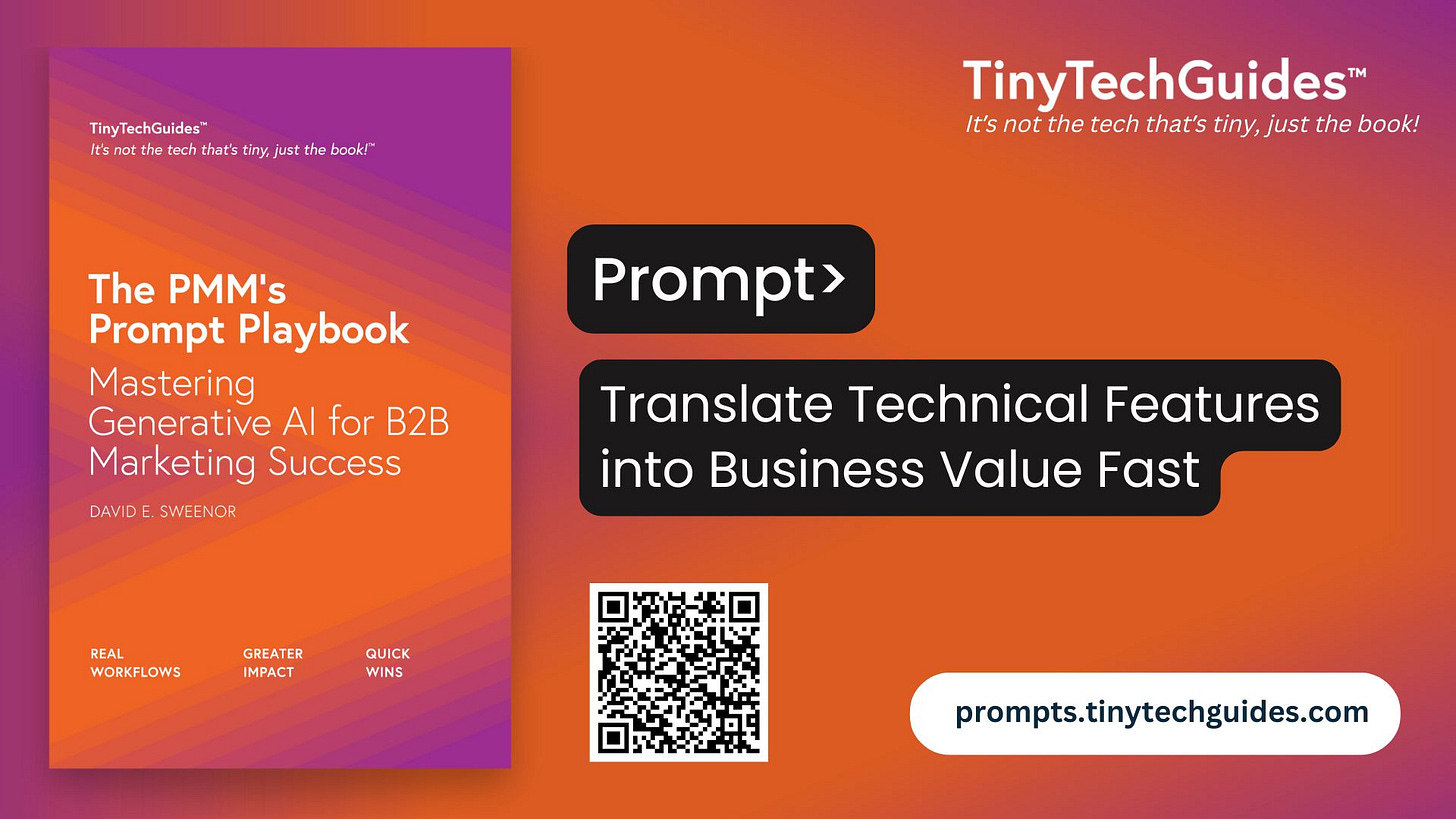Translate Technical Features into Business Value Fast
Bridge the gap between complex product capabilities and what decision-makers care about—cost savings, risk reduction, and real business outcomes.
Technical-to-Business Value Translation
This updated prompt is part of The PMM’s Prompt Playbook which has 30 ready-to-use prompts. If you're looking for more cut-and-paste prompts, join the Substack! Paid subscribers receive new cut-and-paste prompts every week.
Get the PMM’s Prompt Playbook and Modern B2B Marketing today!
What does this do?
The Technical-to-Business Value Translation workflow helps bridge the gap between complex technical features and the tangible business value they deliver. It ensures that product capabilities are communicated in a way that resonates with business decision-makers by focusing on problem-solving, quantifiable outcomes, and audience-specific benefits.
Workflow steps
Simplify technical features into clear, non-technical descriptions
Align features to business problems by identifying pain points they solve
Translate features into measurable business outcomes with quantifiable value
Create audience-specific messaging tailored to different stakeholders
Summarize the final value framework for executive and marketing use
Define the inputs
{industry=Insert your target industry, e.g., enterprise data infrastructure.}{solution=Insert your product/solution, e.g., automated data observability platform.}{audience=Insert your target audience, e.g., CFOs, IT leaders, procurement teams.}{technical features=Insert key technical features, e.g., anomaly detection algorithms, automated root cause analysis.}
Define the objective
<role/>
You are a product marketing expert translating technical product features into clear, outcome-driven business value for {solution} in {industry}.
</role>
<context/>
I need to communicate how the technical features of {solution} solve real-world business problems and deliver measurable outcomes for {audience}. This translation must avoid jargon and focus on business impacts, such as revenue growth, cost reduction, efficiency improvements, or risk mitigation.
</context>
<task/> Translate the following technical features into business value: [Insert a list of technical features, e.g., “automated anomaly detection” or “AI-based performance optimization”].
For each feature:
-Explain the capability in simple terms.
-Describe the business problem it addresses.
-Articulate the business outcome or value delivered (e.g., savings, efficiency, reduced risk).
</task>
<format>
Provide responses in a table format:
Technical Feature
Simplified Capability
Business Problem
Business Outcome
Feature 1: [Technical term]
[Simplified explanation]
[Challenge it solves for the audience]
[Outcome, e.g., 20% reduction in downtime]
Feature 2: [Technical term]
[Simplified explanation]
[Challenge it solves for the audience]
[Outcome, e.g., improved productivity]
</format>
<tone>
Clear, benefit-driven, and business-oriented.
</tone>
Simplify technical features
<role/>
You are a technical communication expert skilled at simplifying complex features into plain language for business stakeholders.
</role>
<context/>
I have a list of technical product features for {solution} that need to be explained in simple terms. Focus on making the capabilities easy to understand without technical jargon.
</context>
<task/>
Rewrite the following technical features in simplified terms that a business executive can understand: [Insert technical features here].
</task>
<format>
Provide the response as a list:
-Feature 1: [Simplified explanation in one sentence].
-Feature 2: [Simplified explanation in one sentence].
Example:
-Technical feature: “AI-based anomaly detection.”
o Simplified Explanation: Automatically identifies unusual activity in real time to prevent costly disruptions.
</format>
<tone>
Clear, concise, and non-technical.
</tone>
Align features to business problems
<role/>
You are a business strategist mapping technical features to real-world business problems for {solution}.
</role>
<context/>
I need to demonstrate how the technical capabilities of {solution} address specific challenges faced by {audience}. Align each feature with a clear business problem it solves.
</context>
<task/>
For each technical feature, identify:
-The **business problem** or challenge it resolves.
-The **pain point** this problem creates for the target audience.
</task>
<format>
Provide responses in bullet points:
-Feature: [Technical feature].
o Business Problem: [The challenge it addresses].
o Pain Point: [The impact or cost of not solving this problem].
Example:
- Feature: Automated anomaly detection.
o Business problem: Systems go offline unexpectedly, causing downtime.
o Pain point: Downtime results in lost revenue and damaged customer trust.
</format>
<tone>
Focused, problem-driven, and audience-relevant.
</tone>
Translate to measurable business outcomes
Keep reading with a 7-day free trial
Subscribe to B2B Marketing Prompts by TinyTechGuides to keep reading this post and get 7 days of free access to the full post archives.


